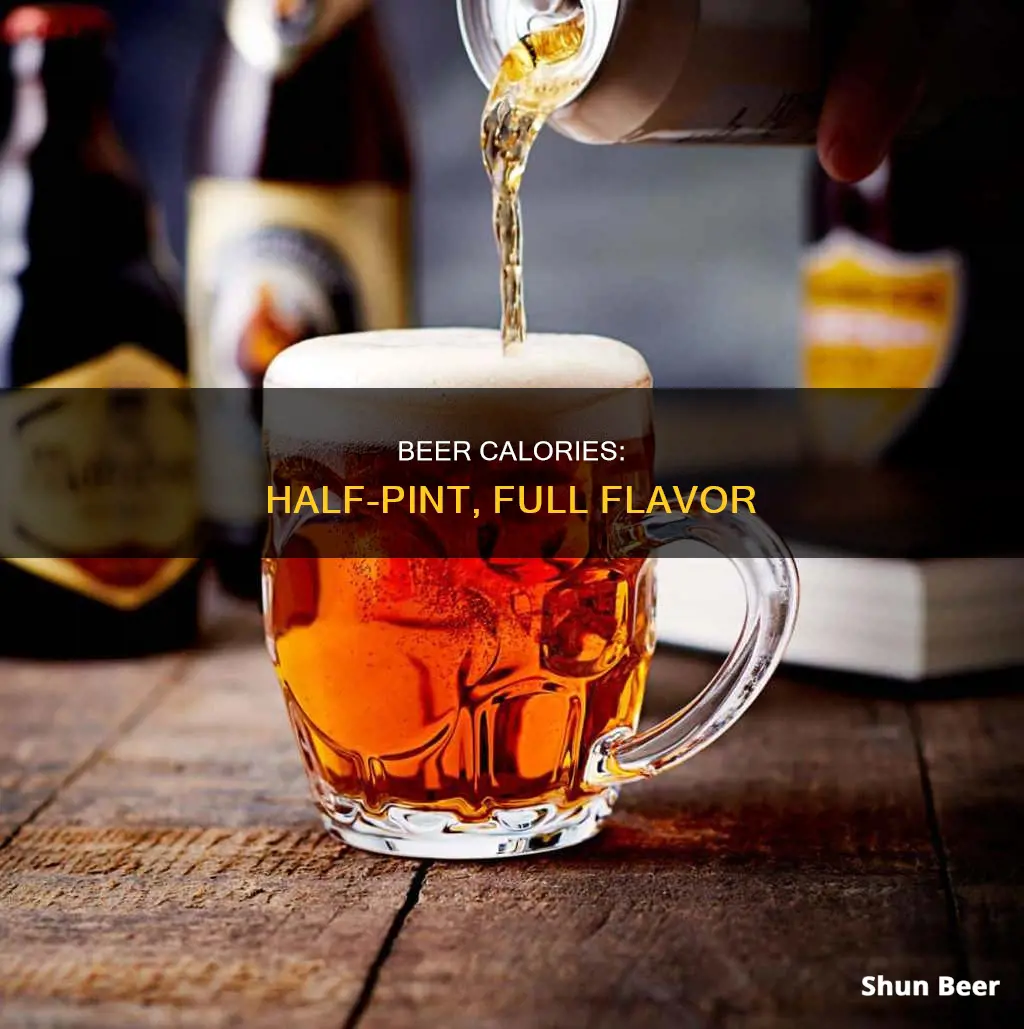
Beer is a popular drink worldwide, but it's important to be aware of its calorie content. Alcohol is high in calories, with around seven calories per gram, almost as many as pure fat. A pint of beer typically contains around 180 calories, but this can vary depending on the type of beer and its alcohol content. For example, a pint of lager with 4% ABV has around 180 calories, while a pint of ale or stout with 5% ABV can contain over 250 calories. These calories are often referred to as empty calories as they provide no nutritional value.
| Characteristics | Values |
|---|---|
| Calories in half a pint of beer | ~90-125 calories |
| Calories in a pint of beer | ~180-250 calories |
| Calories in a can/bottle of beer (330ml) | ~89-338 calories |
| Calories in beer | Dependent on ABV and sugar/carbohydrate content |
What You'll Learn
- Calories in a pint of beer vary depending on the type of beer
- Alcohol is high in calories, with around seven calories per gram
- Beer is believed to have originated in the Middle East almost 5,000 years ago
- Drinking alcohol can cause a delay in the fat-burning process
- Alcohol-free beers usually contain fewer calories

Calories in a pint of beer vary depending on the type of beer
The number of calories in a pint of beer varies depending on the type of beer. On average, a typical pint of beer contains around 215 calories, but this can range from 188 to 257 calories per pint across different brands and styles. The prevailing opinion is that the darker the beer and the denser the head, the more calories it contains. However, this is not always the case, as some lighter beers can have just as many calories as darker ones. For example, Budweiser and Heineken are lighter beers but deliver a higher number of calories than Guinness, a darker beer.
The calories in beer come primarily from alcohol and carbohydrates. About 60% of beer calories come from alcohol, which has seven calories per gram, almost as much as pure fat. The remaining calories come from residual carbohydrates that were not fully fermented during the brewing process. Different types of beer contain different amounts of carbohydrates. For example, lagers tend to have fewer carbs than ales, and ales have fewer carbs than stouts.
The strength of the beer also affects its calorie content. A pint of mid-strength lager with an alcohol content of around 4.5% ABV typically contains 200 calories, while stronger lagers can contain around 235 calories per pint. Lower-alcohol beers, such as non-alcoholic or low-alcohol options, will generally have fewer calories.
It's important to note that while beer can be high in calories, it's not inherently fattening. The occasional pint of beer won't make you gain weight. However, regularly consuming more calories than you need can lead to weight gain. Drinking beer in moderation and choosing lower-alcohol options can help maintain a balanced lifestyle.
Calorie Counting for Beer Brat Lovers
You may want to see also

Alcohol is high in calories, with around seven calories per gram
Alcoholic drinks can be high in calories, with around seven calories per gram. This is almost as many as a gram of fat, which contains nine calories. Alcoholic drinks can therefore quickly add a large number of calories to your daily intake. For example, a couple of drinks can add 500 calories or more.
The calories in beer come from two main sources: alcohol and carbohydrates. About 60% of beer calories come from alcohol, with the rest coming from carbs. Beer is made by fermenting cereals, most commonly malted barley, which produces alcohol. The higher the alcohol content, the more calories the beer will contain. For example, a pint of 4% ABV lager contains around 180 calories, while a pint of strong lager can contain 235 calories.
The calories in alcoholic drinks can also be increased by adding mixer drinks, such as cola or tonic water. Cocktails mixed with soda, juice, cream, or ice cream can have especially high-calorie counts.
If you are watching your weight, it is a good idea to be mindful of the calorie content of alcoholic drinks. Opting for lower-alcohol beers or non-alcoholic options can help to reduce your calorie intake. Drinking a glass of water between each alcoholic drink is another helpful strategy for moderating your intake.
Calories in Flying Dog Beer: Nutritional Breakdown
You may want to see also

Beer is believed to have originated in the Middle East almost 5,000 years ago
The ancient Egyptians also played a significant role in the history of beer. They were skilled brewers, constantly refining their brewing techniques to improve the taste of beer. The most popular beer in Egypt was a honey-flavoured brew called Heqet, and their general word for beer was zytum. Beer was highly valued in Egyptian culture and was often used as compensation for labour. For example, workers at the Giza plateau received beer rations three times a day, and workers on the Nile were sometimes paid for their work in beer.
Beer was also consumed in other ancient civilisations, such as Greece and Rome. However, in these societies, wine was typically considered the drink of the gods, and beer was seen as a lower-class beverage. Despite this, the Romans did brew their own type of beer called cerevisia, and it was one of the most common drinks on the outskirts of the empire.
During the Middle Ages, beer was mostly produced in monasteries across Europe. It was particularly popular in regions where grape cultivation was difficult or impossible, such as the northern and eastern parts of the continent. The monks who brewed beer were allowed to consume up to five litres per day, and the profits from selling beer helped many monasteries survive the Dark Ages.
The first commercial breweries appeared in the 13th century, with beer being produced and sold on a large scale in Germany, England, and Austria. German brewers set the standard for beer makers across Europe, and their beer was known for its high quality and superior taste.
Calories in Beer: DockSider's Nutritional Breakdown
You may want to see also

Drinking alcohol can cause a delay in the fat-burning process
A half-pint of beer, which is about 284 milliliters, contains about 92.5 calories, assuming a 4% ABV lager. Beer calories come mainly from carbs and alcohol. The higher the alcohol content, the more calories the beer will tend to have.
The liver metabolises alcohol in two stages. Firstly, the liver turns the ethanol from alcohol into acetaldehyde, which is relatively toxic to the body and can cause negative side effects such as headaches and nausea. In the second stage, the body works to get rid of the acetaldehyde toxin by turning it into acetic acid, or acetate, which can then be eliminated from the body.
As the body recognises alcohol as a toxin, it will do everything it can to metabolise and eliminate it first. This means that any other consumed calories from sugar or food are put on hold until the alcohol is gone. While this may not be an issue in the short term, if drinking becomes a habit, weight gain may occur.
Additionally, alcohol can affect your organs, particularly the liver, which acts as a "filter" for foreign substances. Excess alcohol consumption can lead to alcoholic fatty liver, which can damage the liver and affect how the body metabolises and stores carbohydrates and fats. This can make it more difficult to lose weight.
It's important to note that drinking in moderation, such as one to two drinks per day, is not likely to cause significant weight gain. However, if weight loss is a priority, decreasing alcohol consumption and opting for drinks with fewer calories and less sugar can be beneficial.
Calorie Counting: Torpedo IPA Beer Edition
You may want to see also

Alcohol-free beers usually contain fewer calories
Beer is made by fermenting cereals, most commonly malted barley, and the calories in beer come primarily from alcohol and carbohydrates. Alcohol contains around seven calories per gram, almost as many as pure fat. The rest of the calories in beer come from residual carbohydrates that were not fully fermented during the brewing process.
Craft, seasonal, and high-alcohol beers tend to have more calories than lighter beers. If you're watching your calorie intake, opting for alcohol-free beers is a good strategy, as these typically contain fewer calories.
The calories in beer are dependent on alcohol levels and sugar/carbohydrate content, with alcohol having the most significant impact due to its higher calorie content per gram compared to carbohydrates. As a result, reducing the alcohol content of a beer is an effective way to lower its calorie count.
For example, a typical pint of beer contains around 215 calories, but this can vary across brands and styles. A pint of mid-strength lager, with an alcohol content of around 4.5% ABV, typically has 200 calories. In contrast, stronger lagers usually have around 235 calories per pint.
Alcohol-free beers, which typically contain less than 0.05% alcohol by volume (ABV), offer a lower-calorie alternative for those who want to cut down on their alcohol consumption without eliminating it entirely. These beers are made using the same ingredients as their standard counterparts but with less alcohol, resulting in a reduced calorie count.
Calorie Count of Alaskan Amber Beer Explained
You may want to see also
Frequently asked questions
The number of calories in half a pint of beer depends on the type of beer and its ABV (alcohol by volume). On average, a pint of 4% ABV lager contains around 180 calories, so half a pint would be around 90 calories.
Yes, there are several low-calorie beer options available. For example, Skinny Lager is a popular low-calorie option that contains 89 calories per 330ml can or bottle.
Beer tends to contain more calories than wine or spirits. For example, a pint of bitter contains around 180 calories, while a glass of red wine is around 119 calories, and a shot of vodka, gin, or whiskey is around 52 calories.







